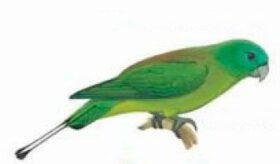Content |
|---|
Description
27 cm.. length between 120 and 160 g. of weight.
The Mindanao Racquet-tail (Prioniturus waterstradti) has the head bright green, with broadcasting slightly more blue-green in the cheeks, the lores and front of the crown. Duller green mantle; olive rump with different shades. The Green wings, with vane Dark internal to the flight feather, narrow marginalized yellow on the edges Interior; carpal edge yellow, wing feathers green; underside of primaries with blue dye.
The underparts brighter yellowish green, more yellow in undertail-coverts. Upper, the tail green, with side feathers blackish tip; undertail, the tail bluish; Blackish spatulas
Bill light grey; Brown irises; legs blackish gray.
females with extensions of tail more short.
- Sound of the Mindanao Racquet-tail.
Subspecies:
-
Prioniturus waterstradti malindangensis
(Mearns, 1909) – Both adults, the color blue in the forecrown and the area under the eyes, paler; less Brown at the back.
-
Prioniturus waterstradti waterstradti
(Rothschild, 1904) – The nominal
Habitat:
It is distributed in the humid montane forest, mainly between 850 and 2000 m, but have been recorded at altitudes of 450 m. Little is known about the habits of this species, that until recently was considered the same species as the Luzon Racquet-tail. Most of the observations refer to small flocks of between two and ten birds.. Apparently lower than other members of its genus is distributed in densities.
Reproduction:
There are no data on its reproductive ecology.
Food:
Without data
Distribution:
Size of the area of distribution (reproduction / resident): 11.300 km2
Endemic to the Highlands of Mindanao, Philippines. The records come from the Mount Apo, the Mount Malindang, Mount Kitanglad, Mount Mayon, Mount Matutum, Mt. Lebo, Anakan, Civolig, the Mount McKinley, Lake Faggamb and Baracatan, But even though the total population is estimated at 5.000 specimens, currently only limited to five mountains.
Subspecies distribution:
-
Prioniturus waterstradti malindangensis
(Mearns, 1909) – Southeast of the mountains of Mindanao (Southeast of Philippines).
-
Prioniturus waterstradti waterstradti
(Rothschild, 1904) – The nominal
Conservation:
• Current IUCN Red List category: Near threatened
• Population trend: Decreasing
In 1993, the population was estimated at 5,000 individuals (Lambert et to the. 1993)
The population is suspected that it may be declining due to the continuous degradation of the forests and the capture for the cage bird trade.
Conservation Actions Proposed:
– Collect data on the impacts of the international and domestic trade.
– Review the estimate of the population.
– Calculate loss of forests within their geographic range and altitude using satellite and remote sensing images.
– Protect effectively important tracts of forest right in key places, both in the areas of strict protection, such as multi-use areas.
"Mindanao Racquet-tail" in captivity:
Not found in captivity.
Alternative names:
– Mindanao Racquet-tail, Crimson-spotted Racket-tailed Parrot, Crimson-spotted Racquet-tailed Parr, Minadnao racket-tailed parrot, Mindanao Montane Racquet-tail, Mindanao Racket-Tail, Mindanao Racket-tailed Parrot, Mindanao Racquet tail, Mindanao Racquet-tailed Parrot (ingles).
– Palette de Mindanao, Palette de Waterstradt, Perroquet à raquette de Mindanao (French).
– Mindanao-Spatelschwanzpapagei, Mindanao Spatelschwanz-Papagei, Mindanaopapagei, Mindano-Spatelschwanzpapagei (German).
– Prioniturus waterstradti (Portuguese).
– Lorito Momoto de Mindanao, Lorito-momoto de Mindanao (español).
scientific classification:
– Order: Psittaciformes
– Family: Psittaculidae
– Genus: Prioniturus
– Scientific name: Prioniturus waterstradti
– Citation: Rothschild, 1904
– Protonimo: Prioniturus waterstradti
Images "Mindanao Racquet-tail"
Video of the "Mindanao Racquet-tail"
————————————————————————————————
“Mindanao Racquet-tail” (Prioniturus waterstradti)
Sources:
– Avibase
– Parrots of the World – Forshaw Joseph M
– Parrots A Guide to the Parrots of the World – Tony Juniper & Mike Parr
– Birdlife
– Sounds: Desmond Allen (Xeno-canto)


